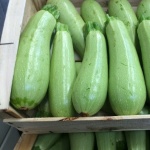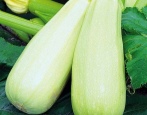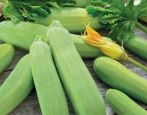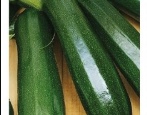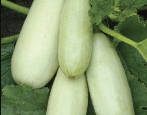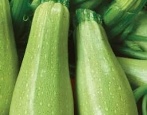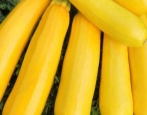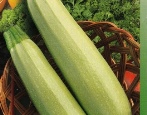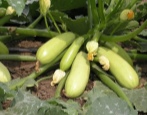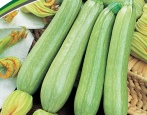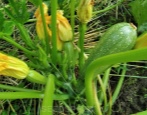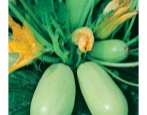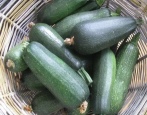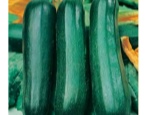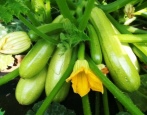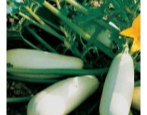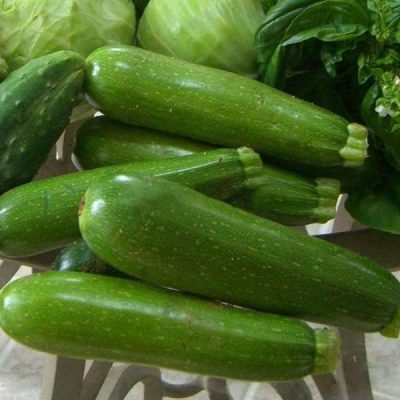
- Year of approval: 1986
- Ripening terms: early maturing
- The period from germination to harvest: 51 days
- Description of the plant: no side shoots
- Leaves: pentagonal, large, dissected, dark green
- Fruit shape: cylindrical, running towards the stalk
- Fruit color: dark green, speckled, light green
- Color of the pulp: white
- Pulp (consistency): juicy, dense, crispy, tender
- Fruit weight, kg: 0,89
Of all the existing zucchini species, Tsukesha occupies a leading position both in yield and in the degree of usefulness for the human body. These zucchini contain a significant amount of trace elements. In addition, they have a phenomenal keeping quality, and in their care they are clearly unpretentious.
Breeding history
Tsukesha appeared as a result of cooperation between domestic and Ukrainian specialists. Included in the State Register in 1986 as a crop for cultivation in greenhouses and in open soils. Cultivated in the Central, Middle Volga and Far Eastern regions.
Description of the variety
This early ripening variety belongs to the zucchini family and is productively grown in places with moderate climatic conditions. The culture is extremely compact and is quite suitable for small summer cottages.
The fruits of the culture are softer than those of ordinary zucchini. They can be consumed even raw as they are easily absorbed without stimulating allergic reactions. They contain a significant amount of vitamins and minerals, being a recognized dietary product.
The pluses of culture include:
- very high yield level;
- early ripening;
- a high degree of tenderness of consistency;
- compactness of bushes;
- versatility in use, transportability and long-term keeping quality (up to 7 months).
Minuses:
- exactingness for regular irrigation and good lighting;
- high level of sensitivity to transplants.
Characteristics of the appearance of plants and fruits
The bushes of the culture are small, weakly branched, with a short main shoot, they do not have lateral lashes. Stems on the soil do not spread, taking up little space. The leaves are dark green, five-toed, large, strongly dissected. On the leaves there are patterns consisting of typical grayish specks. The leaf blades are harsh. The flowers are large, bright, with shades of saffron. Bisexual flowers are formed on one bush, so there are no problems with pollination.
The fruits grow with an intense dark green color and small light green blotches that appear as they ripen. The rind is glossy, thin, but firm. Zucchini of the correct cylindrical configuration, with some tapering towards the stalk. They are about 40 cm long, up to 12 cm in diameter, and weigh up to 0.89 kg. However, they can already be removed when they reach a length of 12-15 cm and a weight of about 200 g. The seeds are small and soft. The consistency is juicy, sonically crispy, white in color, capable of retaining its shape without turning into gruel during boiling and stewing. The fruiting process is friendly.
Purpose and taste
The fruits of the culture are universal in use, have excellent taste properties.
Ripening terms
The culture is early maturing, the time from germination to fruit picking is 51 days. Fruiting is synchronous and abundant.
Yield
The average yield is 11.0-12.0 kg / sq. m.
Growing and care
The gardeners note the exactingness of the culture for competent and systematic irrigation. In addition, the culture has a negative attitude to overdrying the soil, especially during the flowering period and during the formation and ripening of fruits. With a lack of lighting, the yield drops noticeably. Pumpkin is extremely negative about transplanting. The standard planting scheme is 70x70 cm. It should be planted after root crops, tomatoes, onions and legumes.
For planting crops, both the seedling method and sowing by seeds are used. The latter method is more profitable, since the culture is early maturing. The soil for planting is prepared ahead of time. For this purpose, peat and manure (1: 1) are introduced during digging in the spring. Then add nutrient soil (up to 30 cm layer), which is then poured with hot water and covered with a film. After about 24 hours, when the soil warms up to + 15 ° C, they begin sowing seeds.
Sowing seeds for seedlings is carried out in April using peat cups. The seedlings planted in the beds are covered for a while with a non-woven cloth. They remove the shelter after full adaptation of the bushes to new conditions. Experienced gardeners note that zucchini grown by the seedling method are stored worse than those grown from seeds planted directly in the beds.
Seeds are sown in open soils from May 25 to June 10. To do this, make holes up to 3 cm deep. The placed seeds are covered with loosened soil, irrigated, and a film canvas is installed on the plantation. Eliminate it after the emergence of seedlings and stabilization of warm weather.
The culture requires 1 feeding per season. During the flowering period, the bushes are irrigated (under the roots) with liquid organic matter (1 kg of manure per 10 liters of water), which is previously kept for 24 hours. When the first ovary occurs, the zucchini are removed when they reach 15 cm. Subsequent fruits will begin to ripen more quickly and reach large sizes.
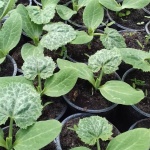
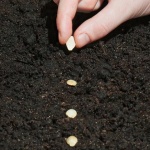
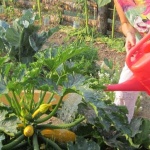
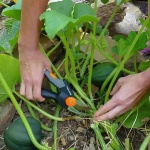
Soil requirements
In general, the culture is unpretentious in relation to the substrate. For seedlings, a universal purchased composition is quite suitable for her. But you can prepare the substrate yourself, mixing humus, nutritious turf, rotted sawdust mass and peat chips (2: 2: 1: 1). The substrate should be disinfected. The plant negatively perceives acidic soils.
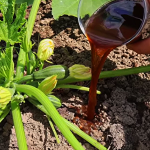
Disease and pest resistance
Harmful insects practically do not linger on bushes. Diseases typical of zucchini appear exclusively during epidemics.
A culture can be exposed to diseases due to the fault of gardeners or in case of pest infestations:
- with constant waterlogging of the soil and irrigation with cold water, rot appears, it is treated with fungicides;
- in case of invasion of caterpillars or aphids, the bushes should be treated with infusions, including wood ash with tooth powder or hot pepper decoction;
- when bacteriosis occurs, the bushes are sprayed with a solution of Bordeaux liquid.
The disadvantage common to all types of zucchini is their predisposition to root rot infection. The first sign of such a pathology is the appearance of cracks on the stems and bare roots. To eliminate the disease, open plant roots are covered with dried sod soil treated with ash.
